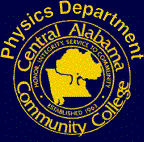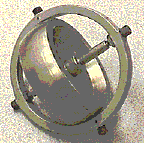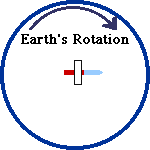

![]()
 A
gyroscope is an object free to spin in space. In the absence of
external torques a gyroscope will maintain its angular momentum. An
external torque applied in the same direction or in a direction
opposite to the angular momentum will cause the gyroscope to speed up
or slow down. If the applied torque has a component which is
perpendicular to the initial angular momentum the gyroscope will
PRECESS. That is, it will start to rotate about an axis which is
perpendicular to the axis of the original spin.
A
gyroscope is an object free to spin in space. In the absence of
external torques a gyroscope will maintain its angular momentum. An
external torque applied in the same direction or in a direction
opposite to the angular momentum will cause the gyroscope to speed up
or slow down. If the applied torque has a component which is
perpendicular to the initial angular momentum the gyroscope will
PRECESS. That is, it will start to rotate about an axis which is
perpendicular to the axis of the original spin.
It appears that in the early years of the 19th century it occurred
to a number of people that a wheel, spinning freely in space, could
be used to demonstrate that the Earth is spinning on its axis.
One suggestion was: "Conceive a large flat wheel, poised on several
axes all passing directly through its center of gravity, and whose
axis of motion is coincident with its principal axis of permanent
rotation, to be put in very rapid motion. The direction of its axis
would then remain unchanged. But the directions of all surrounding
objects varying, on account of the motion of the Earth, it would
result that the axis of the rotating wheel would appear to move
slowly."
 Such
a device, sufficiently precise to be actually useful is not easy to
construct. In principle it might be built as shown in the diagram on
the right.
Such
a device, sufficiently precise to be actually useful is not easy to
construct. In principle it might be built as shown in the diagram on
the right.
Mount the gyro with its axle free to rotate inside a circular ring C.
Now mount the ring C inside a bigger ring B so it is free to rotate
abut an axis which is perpendicular to the main axis of the gyro. Now
mount this assembly so it can rotate about a third axis,
perpendicular to the first two axes.
Such toy gyroscopes are actually for sale. They not very precisely
constructed and they do not rotate for very long.
In 1852 the French physicist Foucalt used such a device to demonstrate the rotation of the Earth. He also coined the word "gyroscope" from two word of Greek origin where the root "gyr" means rotation and the root "scope" means view.
 Suppose
a gyro, located at the North Pole of the Earth is suspended in
equilibrium and allowed to spin freely about a horizontal axis. The
gyro is mounted in such a way that it can rotate freely in space,
about any axis. The gyro will maintain its angular velocity and its
axis will maintain its orientation relative to the fixed stars. As
the Earth turns the gyro will appear to rotate about a vertical axis
as the Earth rotates underneath it.
Suppose
a gyro, located at the North Pole of the Earth is suspended in
equilibrium and allowed to spin freely about a horizontal axis. The
gyro is mounted in such a way that it can rotate freely in space,
about any axis. The gyro will maintain its angular velocity and its
axis will maintain its orientation relative to the fixed stars. As
the Earth turns the gyro will appear to rotate about a vertical axis
as the Earth rotates underneath it.
 Now
consider the same experiment somewhere at the equator. Start the gyro
spinning about a horizontal axis. Again the gyro will maintain this
orientation relative to the fixed stars. As the Earth turns
underneath, the spin axis of the gyro, which was originally
perpendicular to the vertical, will appear to tilt. During a
twenty-four hour day the gyro will appear to turn about a horizontal
axis.
Now
consider the same experiment somewhere at the equator. Start the gyro
spinning about a horizontal axis. Again the gyro will maintain this
orientation relative to the fixed stars. As the Earth turns
underneath, the spin axis of the gyro, which was originally
perpendicular to the vertical, will appear to tilt. During a
twenty-four hour day the gyro will appear to turn about a horizontal
axis.
 The
Earth itself is a spinning object. It is subjected to the
gravitational pulls of other celestial bodies. Of these, the Sun and
the Moon affect the Earth the most. The gravitational pulls of the
Sun and the Moon on the Earth do not pass through the Earth's center
of mass. Therefore the spinning Earth is subjected to a torque which
causes its axis of rotation to
precess. The axis slowly swings around to describe a cone in
space. The axis completes its cycle every 26, 000 years. The axis of
the spinning Earth points to a star that appears to be stationary as
the rest of the sky appears to revolve around it. Since the axis
precesses, during the precession cycle different stars assume that
role.
The
Earth itself is a spinning object. It is subjected to the
gravitational pulls of other celestial bodies. Of these, the Sun and
the Moon affect the Earth the most. The gravitational pulls of the
Sun and the Moon on the Earth do not pass through the Earth's center
of mass. Therefore the spinning Earth is subjected to a torque which
causes its axis of rotation to
precess. The axis slowly swings around to describe a cone in
space. The axis completes its cycle every 26, 000 years. The axis of
the spinning Earth points to a star that appears to be stationary as
the rest of the sky appears to revolve around it. Since the axis
precesses, during the precession cycle different stars assume that
role.
Gyroscopes are incorporated into moving objects from ships and
airplanes to
pointing devices. As these objects move and turn, the gyros inside
try to maintain their angular momentum. Sensors mounted on the gyros
are used to keep track of the motion. Thus gyros are used in
navigation and stabilization devices.
 A
popular classroom
demonstration of the conservation of angular momentum involves a
spinning bicycle wheel, initially supported on both sides of the
axle. When the support is withdrawn from one of the sides, the wheel
starts to precess but does not fall. When one of the axle supports is
removed the force of gravity now exerts a net torque about a
horizontal axis which is not the axis of the spin. The wheel starts
to turn about that axis (i.e. the unsupported side of the axle begins
to drop). The spinning wheel acquires a vertical angular momentum
which by the momentum conservation law should remain zero. To cancel
the new vertical component of the angular momentum the wheel starts
to precess, i.e. to turn about the vertical axis. The energy for this
rotation comes from the decreasing potential energy of the dropping
center of mass of the wheel. When the wheel no longer gains enough
energy to pump into the rotational motion about the vertical axis,
the wheel stops falling.
A
popular classroom
demonstration of the conservation of angular momentum involves a
spinning bicycle wheel, initially supported on both sides of the
axle. When the support is withdrawn from one of the sides, the wheel
starts to precess but does not fall. When one of the axle supports is
removed the force of gravity now exerts a net torque about a
horizontal axis which is not the axis of the spin. The wheel starts
to turn about that axis (i.e. the unsupported side of the axle begins
to drop). The spinning wheel acquires a vertical angular momentum
which by the momentum conservation law should remain zero. To cancel
the new vertical component of the angular momentum the wheel starts
to precess, i.e. to turn about the vertical axis. The energy for this
rotation comes from the decreasing potential energy of the dropping
center of mass of the wheel. When the wheel no longer gains enough
energy to pump into the rotational motion about the vertical axis,
the wheel stops falling.
![]() 1.
What is gyrocompass?.
1.
What is gyrocompass?.
![]() 2.
How are gyros used as stabilizers?
2.
How are gyros used as stabilizers?
![]() 3. Can a spinning top be called a gyro? Does it precess?
3. Can a spinning top be called a gyro? Does it precess?
To get the extra credit send an email message with your answers to
Prof. Nick